Anthurium flowers: how to care for and propagate the plant
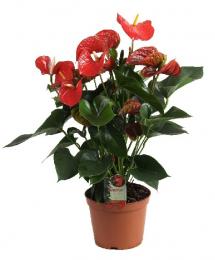
Anthurium flowers are very valuable and decorative. It is a great pride for a gardener to grow an anthurium and achieve its long flowering.
The anthurium flower came to us from America, from its southern and central parts. A flower is being grown as a houseplant.
Growing anthurium is not easy; it is quite whimsical and demanding. You can’t find it in all flower shops; the plant is rare and expensive.
Content:
- Description of the plant, variety for home cultivation
- Anthurium care
- Anthurium flower propagation
- Problems when growing anthurium
Description of the plant, variety for home cultivation
Anthurium is difficult to confuse with other flowers. Its leaves are large, wide, smooth, at the top there are large flowers of bright red color, the bract is slightly wrinkled.
At home you can only grow some varieties, This:
- Crystal
- Scherzer
- Andre
The most decorative is the crystal anthurium variety. It is valued more for its leaves than for its flowers. The leaves have a velvety surface, they are smaller than those of other varieties, and every year the shade of the leaves becomes darker. Silver veins are clearly visible on the leaves.
Scherzer's anthurium is most often grown. The maximum height of the plant is 30 cm, its leaves are more elongated than those of other varieties, reaching a length of 20 cm, fleshy, dark green in color.The flower spadix stands out, has a spiral shape, the bract length is 5 cm.
The Andre variety is larger; under favorable conditions it can grow up to one meter in height. The leaf is not oblong, but heart-shaped. The spadix also stands out, it is straight or slightly bent, the length of the bract is no more than 10 cm.
It is extremely difficult to grow a flower at home and achieve flowering, but it is possible. The plant blooms almost all year round; the flower stalks can be red, pink and even white.
After the color blanket fades, it turns green and turns into a leaf.
For home growing Hybrid varieties are suitable. They are specially bred based on climatic and other external conditions.
Anthurium care

Anthurium is a heat-loving plant, and it is not so important that the room is warm, but that the temperature be constant. The flower can be kept at a temperature of 20-22 degrees. It is strictly forbidden to place the pot in drafts or places where cold air enters.
Leaves do not respond well to direct sunlight. If you place the pot on the windowsill, the plant is shaded by glass or a transparent curtain. You can also choose a semi-shaded place.
Watering should be timely and moderate. The soil should not be waterlogged, and the earthen clod should not be allowed to dry out.
For irrigation, use water at room temperature or slightly warm. In summer, the plant responds well to spraying; dust should be regularly removed from the leaves with a damp sponge. When spraying, you need to make sure that water does not get on the flowers.
Fertilizers are applied twice a week.You can use universal fertilizers for flowering indoor plants, which contain mineral and organic components.
If anthurium flowers appear in your house, you need to know how to care for them in winter. In winter, a dormant period begins, so fertilizing should be stopped or reduced, but do not forget about watering. The soil should always be slightly moist.
In the spring you can start replanting the plant. The pot is chosen low and wide, and a good drainage system is organized.
The root system of anthurium is very fragile, therefore during transplantation you need to try not to damage the roots. When new roots appear above the soil surface, they will need to be covered with moss and ensure that it is constantly moist.
It is recommended to use a mixture of the following components as a growing substrate:
- turf land
- swamp moss
- rough deciduous soil
When planting plants, the soil does not need to be compacted; it should be loose to ensure access of oxygen to the roots. Under no circumstances should the soil be alkaline.
If all conditions are met, the anthurium will bloom all summer, and some varieties almost all year round. The flowering period can begin in February and end in November.
Anthurium flower propagation

There are several methods to obtain new anthurium plants, namely by seeds, stem cuttings, apical cuttings, side shoots and dividing the bush.
In order for anthurium to form seeds, artificial pollination must be carried out; pollen is transferred from inflorescence to inflorescence using a brush. The procedure is repeated over several days.
You can get the fruits no earlier than in a year. Each fruit will contain up to 4 seeds.They are washed and placed for a couple of hours in a solution of potassium permanganate. Seeds should be sown immediately after collection.
Sowing is carried out in a Petri dish or other shallow container on a foam sponge or filter paper. A greenhouse effect is ensured: the seeds are covered with film or glass.
In 2 weeks seeds are transferred to the soil, which is made from 0.5 parts sand, 1 part peat and 2 parts leaf soil, you can also add charcoal or broken brick. After 2 months, the soil is replaced with fresh one.
With each picking, the distance between the seedlings increases. Anthurium is planted in separate pots when the height of the seedling reaches 7 cm. Anthurium will bloom for the first time no earlier than in 4 years.
It is faster and more efficient to propagate anthurium vegetatively. The procedure is carried out in late spring early summer.
Stem shoots, the upper or lower part of the stem with roots, are divided into cuttings and planted in a container, providing a greenhouse effect. Rooting occurs within 2 weeks. The sprout is transplanted into a pot when two full leaves appear.
Problems when growing anthurium
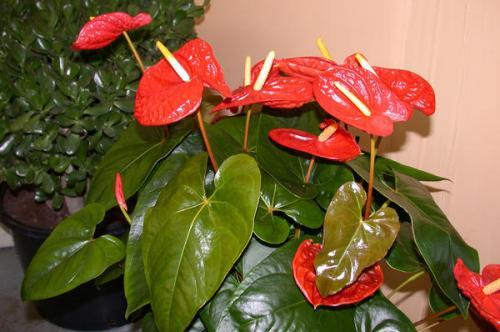
Anthurium is a delicate plant, so many problems can arise when growing. In winter, you may notice that the leaves begin to turn yellow and fall off, which means that the room temperature is low or humidity is high.
The plant must be moved to suitable conditions and the soil must be allowed to dry. In the same way, the plant reacts to sudden changes in temperature.
If the leaves turn yellow and become thinner, then most likely the plant does not have enough moisture. The soil needs to be well watered and continue to maintain a constant level of moisture.If the leaves begin to fade, it means that the anthurium is cold or is exposed to drafts.
If roots appear through the soil, the plant needs to be replanted and the roots covered with damp moss. If new leaves appear on the stem, but flowering does not occur for a long time, then the plant does not have enough fertilizer.
If the leaves are covered with brown spots, it means that the anthurium has been infected by a fungus. Leaves are processed systemic fungicide, care conditions must be provided.
If woolly spots appear on the underside of the leaf, then we are talking about a mealybug. This is a common and harmless problem if addressed early. The plant is treated with a systemic insecticide or malathion.
The plant is finicky, so the appearance of pests can quickly lead to the death of the flower. A florist may encounter the following diseases and parasites:
- round avocado scale
- root-knot nematode
- aphid
- mealybug
- citrus bug
- scale insect
- gray rot
- septoria
For each disease, the affected parts are removed, insects are eliminated mechanically, and the healthy part is treated with special preparations.
At first glance, it seems that creating suitable conditions for anthurium is not so difficult. This is true, the main thing is to follow each point impeccably.
Proper care of Anthurium on video:
Interesting information about the vegetable garden

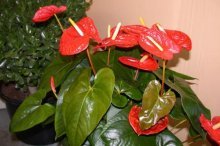
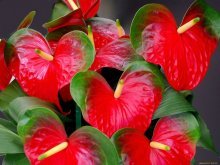

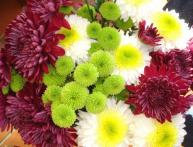

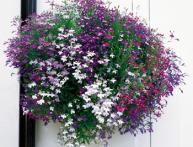
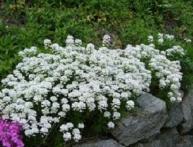

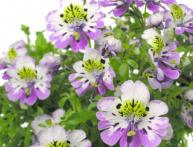
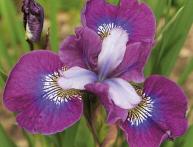
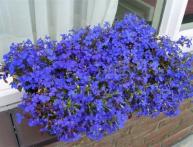
Comments
At one time I was really sick with Athurium, I bought myself an excellent flower, big, beautiful. But for some reason it didn’t stick with me. It grew all year long and bloomed very beautifully. But for some reason it disappeared.((
At one time I was really sick with Athurium, I bought myself an excellent flower, big, beautiful. But for some reason it didn’t stick with me.It grew all year long and bloomed very beautifully. But for some reason it disappeared.((